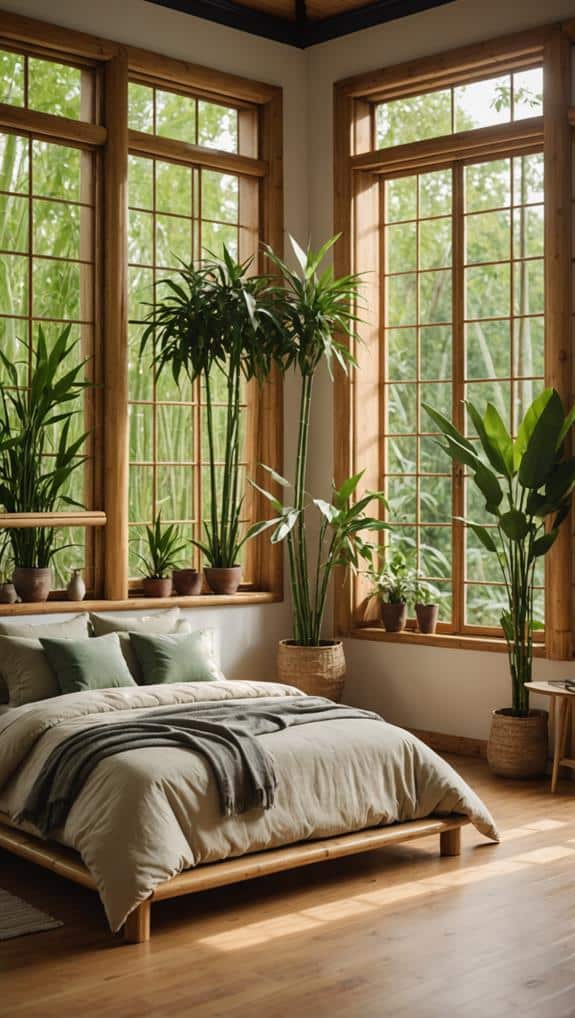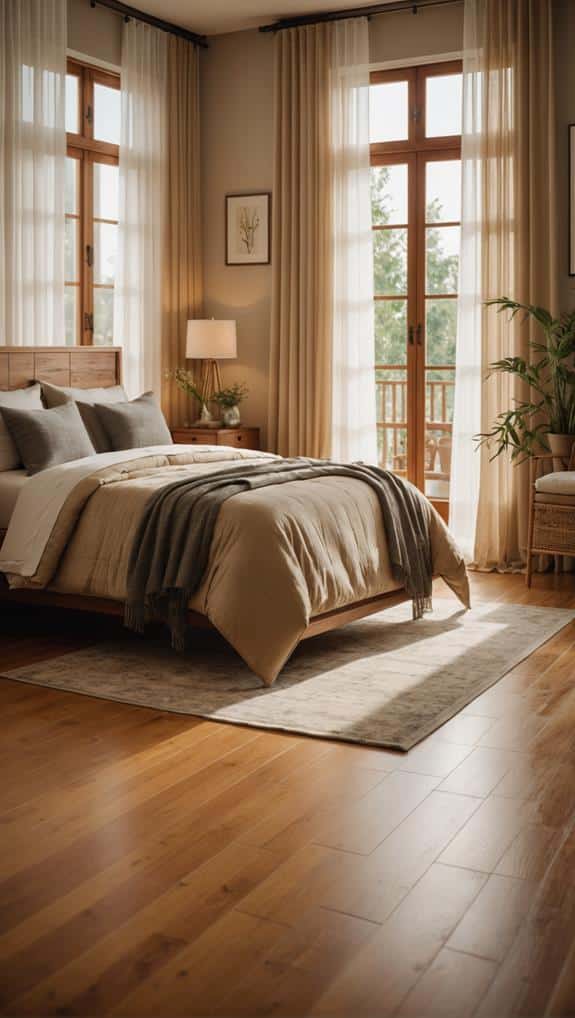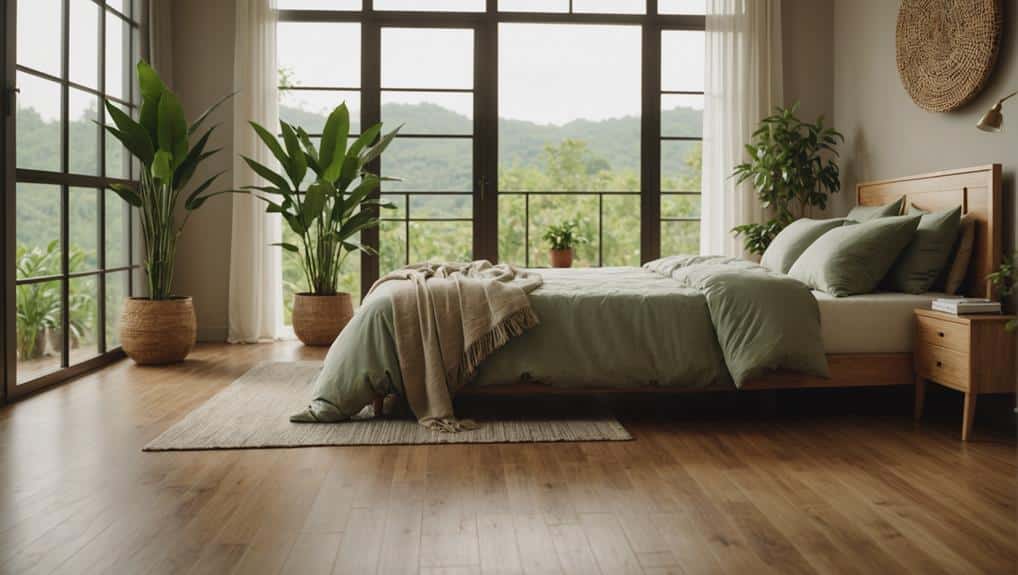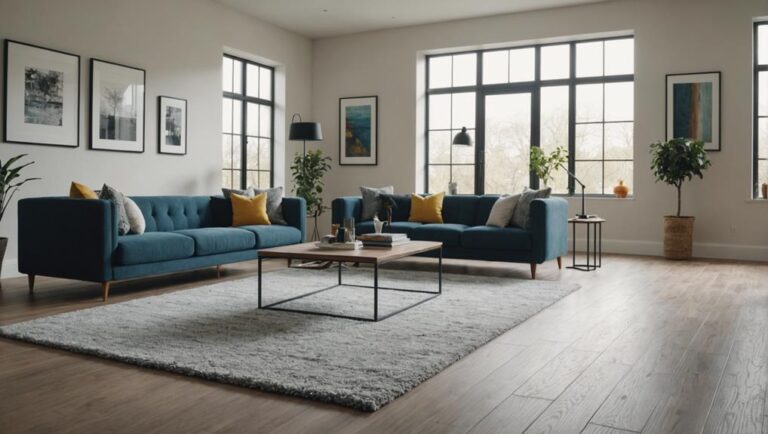In 2025, Chic Refuge invites you to explore ten sustainable bamboo flooring ideas for your bedrooms that seamlessly blend style with eco-friendliness.
First, consider using horizontal or vertical bamboo planks to achieve either a traditional or modern aesthetic. For high-traffic areas, strand-woven bamboo is an excellent choice due to its remarkable durability.
It’s essential to prioritize ethically sourced bamboo from certified suppliers to ensure sustainability.
When it comes to installation, you can opt for floating methods that are DIY-friendly, or choose nail-down techniques for enhanced longevity.
Additionally, selecting natural, low-VOC finishes is key to improving your indoor air quality.
To add warmth and texture, consider layering area rugs crafted from natural fibers.
These thoughtfully selected elements collectively contribute to creating a stylish and sustainable bedroom environment that is worth exploring further.
Key Takeaways
- Choose strand-woven bamboo for high durability in busy bedrooms, ensuring long-lasting performance and style.
- Opt for natural finishes like plant-based oils to enhance bamboo’s appearance while maintaining environmental integrity.
- Incorporate vertical bamboo styles for a modern, sleek look that complements contemporary bedroom decor.
- Use certified suppliers to guarantee sustainable sourcing of bamboo flooring, supporting eco-friendly practices.
- Layer area rugs are made from natural fibers to add warmth and texture, enhancing the aesthetic appeal of bamboo floors.
Benefits of Bamboo Flooring

When it comes to flooring choices, we often find ourselves searching for a balance between style and sustainability. Bamboo flooring offers an impressive combination of both, making it a top contender in today’s eco-conscious market.
One key benefit is bamboo durability; its natural strength means it can withstand heavy foot traffic and last for years. Certain bamboo species, such as Moso, are recognized for their exceptional toughness, outperforming many traditional hardwoods in durability tests.
Moreover, bamboo is a rapidly renewable resource, growing up to three feet in a single day. This regenerative quality not only makes it an environmentally friendly choice but also reduces our carbon footprint when compared to other flooring options. The lighter impact on our planet is something we can all feel good about.
Additionally, bamboo flooring comes in various finishes and grain patterns, allowing us to enhance our interior aesthetics while still making a sustainable decision. It’s also relatively easy to maintain, requiring minimal effort to keep it looking its best.
Choosing bamboo flooring isn’t just a stylish choice; it’s a smart, sustainable investment that aligns with our values as conscientious consumers. Let’s embrace this eco-friendly option and enjoy the benefits together!
Popular Bamboo Flooring Styles

Bamboo flooring styles offer us a delightful range of choices to suit any aesthetic preference. When we explore the different options available, we can choose from various bamboo pattern variations that can dramatically change the ambiance of our bedroom.
For instance, horizontal bamboo flooring showcases a classic and clean look, while vertical bamboo offers a more modern and sleek appearance. Additionally, strand-woven bamboo is incredibly durable, boasting impressive strength, which makes it perfect for high-traffic areas.
The unique bamboo grain aesthetics also play a significant role in our decision-making. With its natural tones and textures, bamboo flooring can effortlessly integrate into different design themes, from minimalistic to rustic.
It’s essential for us to reflect on the finish as well; natural, carbonized, or stained finishes can enhance the distinct characteristics of the bamboo grain, creating a truly customized look.
As we explore these popular styles, we can visualize how each option not only contributes to the beauty of our space but also aligns with our values of sustainability. Embracing these styles can lead us to a stunning, eco-friendly bedroom that reflects our personal taste and commitment to the environment.
Choosing Sustainable Bamboo Options

Selecting sustainable bamboo options is vital for ensuring our flooring choice aligns with eco-friendly practices.
When we explore bamboo flooring, it’s important to prioritize products made from responsibly sourced materials. This means opting for brands with established bamboo sourcing practices and a commitment to sustainable manufacturing.
Here are some key points to reflect on:
- Certified Suppliers: Look for bamboo flooring from suppliers certified by organizations like the Forest Stewardship Council (FSC).
- Locally Sourced Bamboo: Choose brands that source bamboo locally to minimize transportation emissions and support local economies.
- Low-Impact Production: Seek out manufacturers that utilize processes designed to reduce waste and energy consumption during production.
- Natural Finishes: Opt for finishes that are non-toxic and environmentally friendly, avoiding harmful chemicals.
- Recyclable or Biodegradable Options: When possible, select flooring options that can be easily recycled at the end of their life cycle or are made from biodegradable materials.
Installation Methods for Bamboo

For a successful bamboo flooring project, understanding the various installation methods is crucial. We’ve two primary techniques to evaluate: floating installation and nail down installation.
Floating installation is one of the most popular choices for DIY enthusiasts. It allows us to lay the bamboo planks over an underlayment without securing them to the subfloor.
This method provides flexibility, making it ideal for areas prone to humidity and temperature changes, as the floor can expand or contract naturally.
On the other hand, if we’re looking for a more permanent solution, nail down installation might be the right path for us. With this method, we attach the bamboo directly to a plywood or concrete subfloor using nails or staples.
It offers a strong, durable finish, ideal for high-traffic areas. However, it’s significant to mention that this installation method can be more complex, requiring additional tools and experience.
In deciding between these methods, we should evaluate both our skill level and the specific needs of our space.
Ultimately, choosing the right installation technique will guarantee that our bamboo flooring looks great and stands the test of time.
Maintaining Bamboo Bedroom Floors

After choosing the right installation method for our bamboo flooring, maintaining its beauty and functionality is the next step. We want our floors to shine while being protected from wear and tear.
Adopting effective cleaning techniques and protective measures will go a long way in achieving this.
Here are some tips we can follow to maintain our bamboo bedroom floors:
- Use a soft-bristle broom: Regular sweeping helps clear dirt and debris without scratching the surface.
- Mop with a damp cloth: Using a microfiber mop with a mild, pH-balanced cleaner keeps our floors looking fresh; avoid excessive water.
- Place mats at entryways: Prevent dirt from tracking inside by using mats at doors.
- Avoid high heels and heavy furniture: These can dent our bamboo flooring, so be cautious about footwear and furniture choices.
- Keep the humidity balanced: Bamboo is sensitive to changes in moisture; maintaining a stable humidity level guarantees longevity.
Bamboo Flooring Vs. Hardwood

When we compare bamboo flooring to traditional hardwood, we find a host of compelling differences that can influence our choice between the two.
First, let’s consider bamboo durability. Bamboo is renowned for its strength; it’s often harder than many hardwood species, making it an excellent option for high-traffic areas. This durability guarantees it withstands the test of time, reducing the need for replacements.
On the other hand, hardwood, while classic and time-tested, may not always match that durability, especially in susceptible spaces.
Next, let’s discuss bamboo aesthetics. Bamboo flooring boasts a unique and modern look that appeals to many homeowners. Its straight grains and natural hues can create a serene atmosphere and complements various design styles.
Meanwhile, hardwood flooring, with its diverse species and rich textures, offers a traditional touch that never truly goes out of style.
Ultimately, our choice between bamboo and hardwood often boils down to our personal preferences and lifestyle needs.
Eco-Friendly Finishes and Treatments

Choosing bamboo flooring not only highlights our commitment to style and durability but also opens the door to eco-friendly finishes and treatments that enhance its sustainability.
By opting for the right finishes, we can protect our investment while guaranteeing we’re not compromising the planet.
To maximize both aesthetics and eco-friendliness, consider these options:
- Natural Sealants: These are derived from plant-based oils and waxes, providing safety and reducing harmful chemical exposure.
- Low VOC Treatments: By using products with low Volatile Organic Compounds, we minimize indoor air pollution for healthier spaces.
- Water-Based Finishes: Eco-conscious and efficient, these finishes provide a durable protective layer without toxic solvents.
- Bamboo-Specific Oils: Some oils are formulated specifically for bamboo, nurturing the natural beauty while enhancing protection.
- Green Certifications: Look for products with certifications like GREENGUARD, which guarantees minimal environmental impact.
Choosing eco-friendly finishes not only supports bamboo’s innate sustainability but also enriches our living spaces with a healthy, stylish atmosphere.
Area Rugs to Complement Bamboo

A well-chosen area rug can enhance the beauty of bamboo flooring while providing warmth and texture to our living spaces. When selecting an area rug, we should consider various area rug patterns that not only complement the natural grain of bamboo but also help to define our space. Geometric designs can add a modern touch, while floral patterns infuse a sense of nature, softening the overall look.
Incorporating diverse rug material options is equally important. Natural fibers, such as jute or wool, are sustainable choices that can harmonize beautifully with bamboo. These materials not only feel great underfoot but also stand up to everyday living, making them practical for our bedrooms.
We might opt for a plush pile for a cozy vibe or a flatweave for easier maintenance.
Ultimately, the goal is to create a cohesive atmosphere that enhances the unique characteristics of our bamboo flooring. By mixing textures and patterns in a thoughtful way, we can elevate our design while ensuring comfort and style.
Let’s embrace the possibilities area rugs offer to achieve an inviting and sustainable bedroom environment.
Color and Texture Considerations

Considering color and texture in our bamboo bedroom design can greatly impact the space’s overall aesthetic and feel.
Bamboo offers a stunning range of shades and grain patterns that allow us to create a cozy yet elegant atmosphere. Its versatility means we can select tones that suit our personal style, whether we lean towards warm earth tones or cooler, contemporary shades.
When choosing bamboo flooring, let’s keep these considerations in mind:
- Light vs. Dark Shades: Lighter shades can make a room feel more open and airy, while darker hues bring warmth and depth.
- Natural Grain Patterns: Each plank has unique grain patterns, adding character and individuality to our space.
- Finish Options: A matte finish creates a rustic vibe, while a glossy finish elevates sophistication.
- Accents and Accessories: We can complement our flooring’s color with furnishings and decor that reflect our chosen palette.
- Lighting Effects: Remember that natural and artificial light can change how the colors appear throughout the day.
Budgeting for Bamboo Flooring

When we’ve settled on the perfect color and texture for our bamboo flooring, it’s time to take a closer look at our budget. We want to verify that our investment not only enhances our bedroom but also remains financially viable. Fortunately, there are cost-effective options available that can fit a variety of budgets.
First, we should research different brands and styles. Some manufacturers offer high-quality bamboo flooring at competitive prices, guaranteeing we get the best value for our money. We might also consider pre-finished bamboo planks, which eliminate the need for additional finishing costs.
If we’re still concerned about the overall expense, exploring financing solutions can alleviate some pressure. Many retailers offer flexible plans, allowing us to break down payments into manageable monthly installments.
This way, we can enjoy our new flooring without the stress of a large lump-sum payment.
Ultimately, by carefully evaluating our choices and looking into financing options, we can achieve a beautiful, sustainable bamboo floor that fits our vision and budget.
With a bit of research and planning, it’s possible to create a stunning space without straining our finances.
Frequently Asked Questions
How Long Does Bamboo Flooring Last Compared to Hardwood?
Bamboo flooring lasts nearly as long as a hardwood tree’s lifetime! We’ve noticed bamboo durability can range from 20 to 25 years. If we follow proper maintenance tips, it can really shine for even longer!
Is Bamboo Flooring Suitable for Homes With Pets?
We believe bamboo flooring can be suitable for homes with pets. It offers comfort for our furry friends, and with proper floor maintenance, it can withstand scratches while keeping our living spaces stylish and functional.
Can Bamboo Floors Be Refinished or Repaired Easily?
We’ve found that bamboo floors can be refinished with proper care, enhancing their durability. While bamboo flooring maintenance is essential, repairing scratches or dents can be manageable, ensuring our spaces remain beautiful and resilient.
What Is the Environmental Impact of Bamboo Harvesting?
We’ve learned that over 30% of the bamboo ecosystem thrives due to sustainable harvesting. This method not only preserves habitats but also reduces carbon footprint, illustrating how bamboo can be an eco-friendly choice for everyone.
Are There Any Health Concerns Associated With Bamboo Flooring?
We recognize there are health concerns with bamboo flooring. Some people might have bamboo allergies, and emissions concerns from adhesives can arise. It’s crucial to choose low-VOC options to guarantee our living space remains safe and comfortable.





